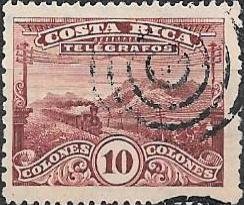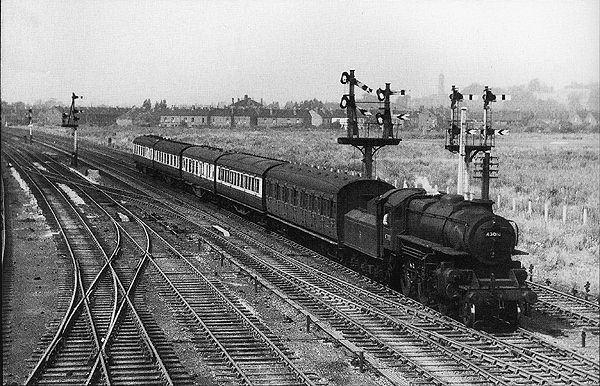Stamp: Landscape and train (Costa Rica 1907)
Landscape and train (Costa Rica 1907)
01 January (Costa Rica ) within release Landscape and Train goes into circulation Stamp Landscape and train face value 5 Costa Rican colón
| Stamp Landscape and train in catalogues | |
|---|---|
| Yvert et Tellier: | Yt:CR TT12A |
| Yvert et Tellier: | Yt:CR TT12A |
Stamp is horizontal format.
Also in the issue Landscape and Train:
- Stamp - Landscape and train face value 5;
- Stamp - Landscape and train face value 5;
- Stamp - Landscape and train face value 10;
- Stamp - Landscape and train face value 10;
- Stamp - Landscape and train face value 25;
- Stamp - Landscape and train face value 50;
- Stamp - Landscape and train face value 50;
- Stamp - Landscape and train face value 2;
- Stamp - Landscape and train face value 2;
- Stamp - Landscape and train face value 5;
- Stamp - Landscape and train face value 5;
- Stamp - Landscape and train face value 5;
- Stamp - Landscape and train face value 5;
- Stamp - Landscape and train face value 10;
- Stamp - Landscape and train face value 25;
- Stamp - Landscape and train face value 25;
- Stamp - Landscape and train face value 50;
- Stamp - Landscape and train face value 2;
- Stamp - Landscape and train face value 5;
- Stamp - Landscape and train face value 5;
- Stamp - Landscape and train face value 5;
Stamp Landscape and train it reflects the thematic directions:
A landscape is the visible features of an area of land, its landforms and how they integrate with natural or man-made features. A landscape includes the physical elements of geophysically defined landforms such as (ice-capped) mountains, hills, water bodies such as rivers, lakes, ponds and the sea, living elements of land cover including indigenous vegetation, human elements including different forms of land use, buildings and structures, and transitory elements such as lighting and weather conditions. Combining both their physical origins and the cultural overlay of human presence, often created over millennia, landscapes reflect a living synthesis of people and place that is vital to local and national identity. The character of a landscape helps define the self-image of the people who inhabit it and a sense of place that differentiates one region from other regions. It is the dynamic backdrop to people’s lives. Landscape can be as varied as farmland, a landscape park, or wilderness. The earth has a vast range of landscapes, including the icy landscapes of polar regions, mountainous landscapes, vast arid desert landscapes, islands and coastal landscapes, densely forested or wooded landscapes including past boreal forests and tropical rainforests, and agricultural landscapes of temperate and tropical regions.
A landscape is the visible features of an area of land, its landforms and how they integrate with natural or man-made features. A landscape includes the physical elements of geophysically defined landforms such as (ice-capped) mountains, hills, water bodies such as rivers, lakes, ponds and the sea, living elements of land cover including indigenous vegetation, human elements including different forms of land use, buildings and structures, and transitory elements such as lighting and weather conditions. Combining both their physical origins and the cultural overlay of human presence, often created over millennia, landscapes reflect a living synthesis of people and place that is vital to local and national identity. The character of a landscape helps define the self-image of the people who inhabit it and a sense of place that differentiates one region from other regions. It is the dynamic backdrop to people’s lives. Landscape can be as varied as farmland, a landscape park, or wilderness. The earth has a vast range of landscapes, including the icy landscapes of polar regions, mountainous landscapes, vast arid desert landscapes, islands and coastal landscapes, densely forested or wooded landscapes including past boreal forests and tropical rainforests, and agricultural landscapes of temperate and tropical regions.
Railways - Transportation system made up of metal rails which is designed to allow trains to maneuver on the tracks from one location to the next.
Railways - Transportation system made up of metal rails which is designed to allow trains to maneuver on the tracks from one location to the next.
Transport or transportation is the movement of people, animals and goods from one location to another. Modes of transport include air, rail, road, water, cable, pipeline and space. The field can be divided into infrastructure, vehicles and operations. Transport is important because it enables trade between people, which is essential for the development of civilizations.
Transport or transportation is the movement of people, animals and goods from one location to another. Modes of transport include air, rail, road, water, cable, pipeline and space. The field can be divided into infrastructure, vehicles and operations. Transport is important because it enables trade between people, which is essential for the development of civilizations.



